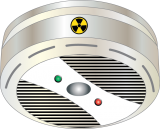Radionuclide Basics: Americium-241
Americium (chemical symbol Am) is a man-made radioactive metal that is solid under normal conditions. Americium is produced when plutonium absorbs neutrons in nuclear reactors or during nuclear weapons tests. Americium-241 is the most common form of Americium.
On this page:
Americium-241
Americium in the Environment
Am-241 found in the environment is in the form of microscopic dust.
- When released into air, americium deposits particles in the soil and water. Small particles in air can travel far from the release site.
- In water, americium will stick to particles in the water or to the sediment at the bottom.
- Deposited on soil, americium will stick to surface particles, but not go very deep into the ground.
- Plants and vegetation growing in or nearby contaminated soil may take up small amounts of americium from the soil.
Americium Sources

Exposure to any significant amount of Am-241 is unlikely under normal circumstances. Small amounts of it are found in the soil, plants and water from nuclear weapons testing.
Some smoke detectors contain very small amounts of Am-241. There is no health risk from americium in smoke detectors as long as the detector is not tampered with and is used as directed. When disposing of a smoke detector, follow manufacturer instructions or check with your local fire department for instructions.
Americium and Health
Am-241 is primarily an alpha emitter, but also emits some gamma rays. It poses a more significant risk if ingested (swallowed) or inhaled. Once in the body, it tends to concentrate in the bone, liver, and muscle. Americium can stay in the body for decades and continue to expose the surrounding tissues to radiation, increasing the risk of developing cancer.
